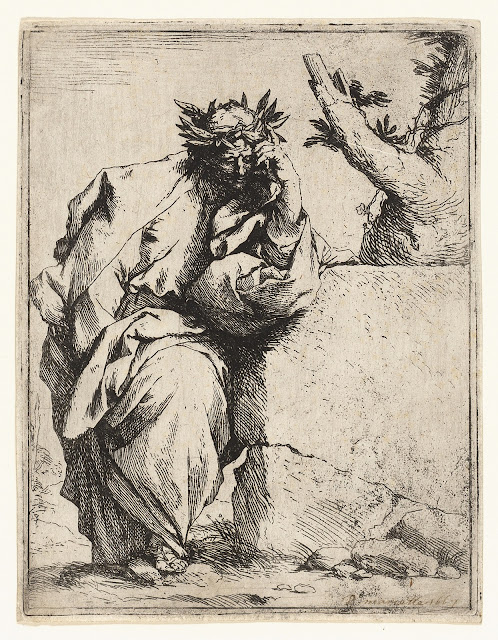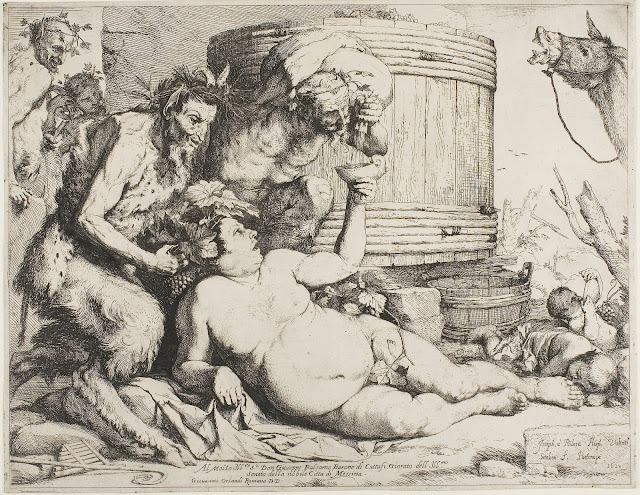 |
| Jusepe de Ribera Studies of a Man's Head ca. 1622 drawing Princeton University Art Museum |
 |
| Jusepe de Ribera Studies of Eyes ca. 1622 etching Princeton University Art Museum |
 |
| Jusepe de Ribera The Poet ca. 1620-30 etching Art Institute of Chicago |
 |
| Jusepe de Ribera St Jerome listening to the Trumpet of the Last Judgment ca. 1622-25 etching Art Institute of Chicago |
 |
| Jusepe de Ribera St Jerome reading ca. 1622-26 etching Rijksmuseum, Amsterdam |
 |
| Jusepe de Ribera Samson and Delilah ca. 1620-26 drawing Museo de Bellas Artes de Córdoba (Spain) |
"Ribera may have come to Italy as early as 1606-1609, probably via Naples, then under the control of Spanish viceroys. He would then have passed through Rome on his way to Lombardy, where he is recorded by several contemporary sources as an already established painter. He is first documented in Parma in 1611, when he received payment for a Saint Martin and the Beggar (lost, known in copies) for the church of San Prospero. The artist is next documented in Rome in 1613 as a member of the Accademia di San Luca. The works of these years, such as the series of the Five Senses, reveal Ribera's intimate study of Caravaggio and his followers. Ribera's naturalism is tempered, however, by a monumentality of the human figure based on careful study of Roman cinquecento masters, such as Raphael, whom Ribera himself cited as a touchstone of his art, as well as ancient sculpture. . . . Ribera is next documented in Naples in September 1616, when he married the daughter of the Neapolitan painter Gian Bernardino Azzolino, called Il Siciliano. This marriage suggests prior contacts with Naples and in fact Ribera soon established himself as an important painter there. Aside from a brief trip to Rome in 1620-21 to learn the art of etching, and another in 1626 to receive the Order of Christ of Portugal from Pope Urban VIII Barberini, Ribera is not known to have left Naples. The few etchings of the 1620s were probably executed to make his works better known, and subsequently carried his fame into northern Europe. . . . Although essentially Italian in training and style, Ribera had great influence on painters in Spain and indeed throughout Europe. His modified Caravaggism informed the course of Neapolitan painting in the first half of the seventeenth century when many important artists passed through his studio, among them the Master of the Annunciation to the Shepherds and Aniello Falcone. The dominant personality in Neapolitan painting of the later seventeenth century, Luca Giordano also began his career as a follower of Ribera."
– from the artist's biography in the Systematic Catalogue of the National Gallery of Art, Washington DC
 |
| Jusepe de Ribera Martyrdom of St Bartholomew 1624 etching Harvard Art Museums |
 |
| Jusepe de Ribera Martyrdom of St Bartholomew ca. 1630-50 drawing Teylers Museum, Haarlem |
 |
| Jusepe de Ribera Drunken Silenus ca. 1628 etching Art Institute of Chicago |
 |
| Jusepe de Ribera Martyrdom of St Sebastian ca. 1630 drawing Princeton University Art Museum |
 |
| attributed to Jusepe de Ribera Marsyas bound to a Tree ca. 1630-40 drawing Morgan Library, New York |
 |
| Jusepe de Ribera Scene of Martyrdom ca. 1630-50 drawing Teylers Museum, Haarlem |
 |
| Jusepe de Ribera Descent from the Cross ca. 1630-50 etching Yale University Art Gallery |
 |
| Jusepe de Ribera Cupid punishing a Satyr ca. 1630-50 etching Art Institute of Chicago |